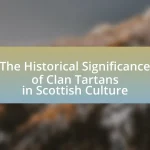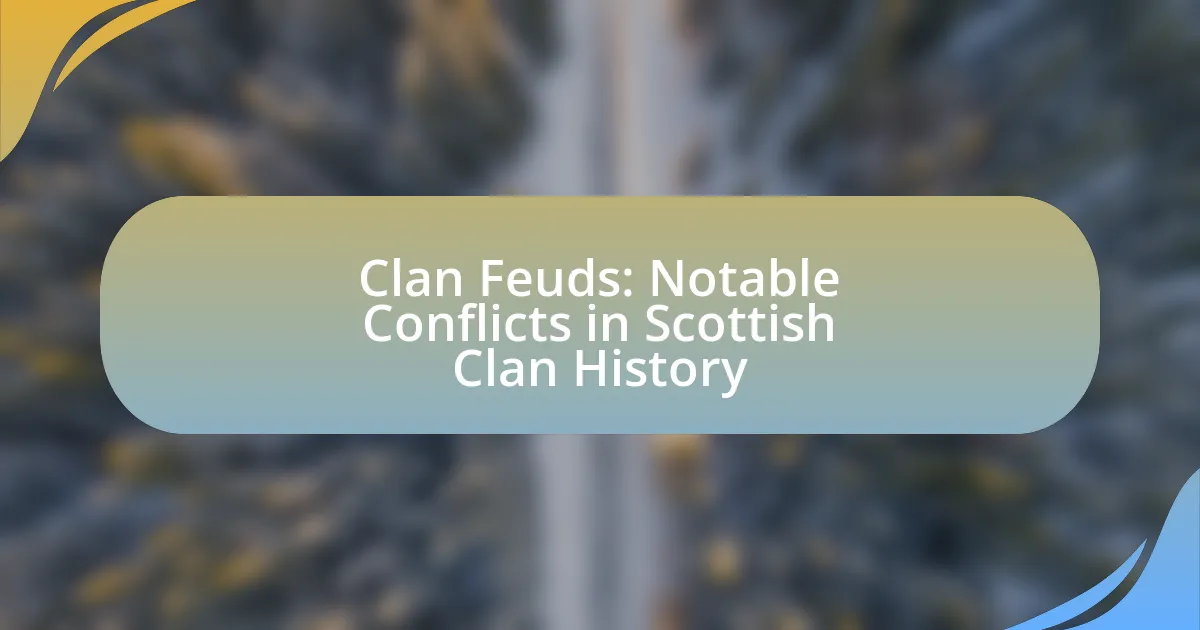The Highland Clearances were a series of forced evictions in the Scottish Highlands from the late 18th to mid-19th centuries, primarily driven by landowners’ shift from traditional farming to sheep farming. This transition resulted in the displacement of approximately 15,000 to 20,000 Highland tenants, leading to significant social upheaval, the dismantling of clan structures, and a decline in population as many emigrated abroad. Key figures, such as the Duke of Sutherland and estate manager Patrick Sellar, played crucial roles in implementing these evictions, which fundamentally altered land ownership and usage patterns. The Clearances not only disrupted traditional clan hierarchies but also influenced contemporary Scottish identity and discussions on land rights, highlighting the long-term impacts of these historical events on Scottish society.

What were the Highland Clearances?
The Highland Clearances were a series of forced evictions that took place in the Scottish Highlands from the late 18th century to the mid-19th century. These evictions were primarily driven by landowners’ desire to convert land from traditional farming to more profitable sheep farming, leading to the displacement of thousands of Highland tenants. Historical records indicate that between 1750 and 1860, approximately 15,000 to 20,000 people were forcibly removed from their homes, significantly disrupting clan structures and traditional ways of life in the Highlands.
How did the Highland Clearances begin?
The Highland Clearances began in the late 18th century as landowners sought to increase agricultural productivity by replacing traditional farming practices with sheep farming. This shift was driven by economic pressures and the demand for wool, leading to the eviction of many tenant farmers from their lands. Historical records indicate that between 1750 and 1860, thousands of Highland Scots were forcibly removed from their homes, resulting in significant social upheaval and the dismantling of clan structures. The clearances were often marked by violent evictions and the destruction of homes, fundamentally altering the demographic and cultural landscape of the Scottish Highlands.
What were the socio-economic factors leading to the Highland Clearances?
The socio-economic factors leading to the Highland Clearances included agricultural changes, population growth, and economic pressures from landowners. The shift from subsistence farming to more profitable sheep farming prompted landlords to evict tenants to maximize profits. Additionally, the population in the Highlands increased significantly during the 18th and early 19th centuries, creating pressure on land resources. This combination of economic incentives for landowners and demographic pressures on the land contributed to widespread evictions, as evidenced by the displacement of thousands of Highlanders between the 1750s and 1860s.
Who were the key figures involved in the Highland Clearances?
The key figures involved in the Highland Clearances included landowners such as the Duke of Sutherland, who was a prominent proponent of the clearances, and factors like Patrick Sellar, who implemented eviction policies. The Duke of Sutherland’s decisions led to the displacement of thousands of tenants from their ancestral lands in the late 18th and early 19th centuries. Patrick Sellar, acting as the estate manager, was notorious for his harsh eviction methods, which included the destruction of homes and crops. These actions significantly altered clan structures, as traditional landholding patterns were disrupted, leading to social upheaval and migration.
What were the consequences of the Highland Clearances?
The consequences of the Highland Clearances included significant depopulation, social disruption, and the dismantling of traditional clan structures. The forced eviction of approximately 15,000 to 20,000 Highland Scots between the 1750s and 1860s led to a dramatic decline in the population of the Highlands, as many were displaced to urban areas or emigrated to countries like Canada and the United States. This mass displacement resulted in the erosion of clan identities and the traditional social fabric, as families were separated and communal ties weakened. Additionally, the Clearances facilitated the transition from a subsistence economy based on agriculture to one focused on sheep farming, further altering the economic landscape and diminishing the role of clans in local governance and community life.
How did the Clearances affect the population of the Highlands?
The Clearances significantly reduced the population of the Highlands, leading to widespread depopulation and displacement. Between the 18th and 19th centuries, approximately 200,000 people were forced to leave their homes due to landowners prioritizing sheep farming over traditional crofting. This mass eviction resulted in the collapse of clan structures, as families were uprooted and communities fragmented, fundamentally altering the social fabric of Highland society.
What impact did the Clearances have on land ownership and usage?
The Highland Clearances significantly altered land ownership and usage by displacing tenant farmers and consolidating land into larger estates. This process, which occurred primarily in the 18th and 19th centuries, resulted in the transition from communal landholding systems to private ownership, where land was often used for sheep farming instead of traditional agriculture. Historical records indicate that approximately 15,000 people were forcibly removed from their homes in Sutherland alone between 1811 and 1820, leading to a dramatic shift in land use patterns and the decline of the clan-based social structure that had previously governed land tenure.

How did the Highland Clearances affect clan structures?
The Highland Clearances significantly disrupted traditional clan structures by forcibly displacing many Highland families from their ancestral lands. This displacement led to the breakdown of clan loyalty and kinship ties, as people were scattered across different regions and often relocated to urban areas or overseas. Historical records indicate that between 1750 and 1860, tens of thousands of Highlanders were evicted, which weakened the social fabric of clans that had previously relied on communal landholding and mutual support. The loss of land and the subsequent migration diminished the power and influence of clan chiefs, altering the hierarchical structure that had defined Highland society for centuries.
What changes occurred in clan leadership during and after the Clearances?
During and after the Clearances, clan leadership underwent significant transformations, primarily characterized by the decline of traditional clan chiefs and the rise of landowners and external landlords. The Highland Clearances, which occurred from the late 18th century to the mid-19th century, led to the displacement of many Highland families, diminishing the power and influence of clan chiefs who had historically governed their communities. As land was increasingly consolidated into larger estates, often owned by lowland landlords or absentee owners, the traditional clan structure weakened, resulting in a loss of local governance and cultural identity. This shift was evidenced by the transition from clan-based authority to a more centralized, capitalist land management system, which prioritized profit over community welfare.
How did the Clearances alter traditional clan hierarchies?
The Clearances significantly disrupted traditional clan hierarchies by displacing many clan members from their ancestral lands, leading to a breakdown of the social structures that had defined clan life. As landowners prioritized sheep farming over tenant farming, many clans lost their economic base, which diminished the power and influence of clan leaders. Historical records indicate that between 1750 and 1860, approximately 200,000 Highland Scots were forcibly removed from their homes, resulting in the erosion of clan loyalty and the fragmentation of clan identities. This shift not only weakened the authority of clan chiefs but also transformed the social fabric of Highland communities, as displaced individuals sought new lives in urban areas or abroad, further diluting traditional clan affiliations.
What role did clan chiefs play in the Clearances?
Clan chiefs played a significant role in the Highland Clearances by facilitating the eviction of tenants from their lands. Many clan chiefs, motivated by economic pressures and the desire to increase profitability through sheep farming, enacted policies that led to the displacement of their own clanspeople. Historical records indicate that between the 1760s and the 1850s, thousands of Highland Scots were forcibly removed from their homes, often with the support or direct involvement of their chiefs, who sought to modernize their estates and align with the agricultural changes of the time. This shift not only disrupted traditional clan structures but also contributed to a profound social and cultural transformation in the Highlands.
How did clan identities evolve as a result of the Clearances?
Clan identities evolved significantly as a result of the Clearances, primarily due to the forced displacement of Highland populations and the dismantling of traditional clan structures. The Clearances, which occurred from the late 18th to the mid-19th century, led to the eviction of many families from their ancestral lands, resulting in a loss of communal ties and a shift towards individualism. This disruption caused clans to lose their cohesive identity, as members were scattered across different regions and even emigrated abroad, particularly to North America and Australia.
The decline of the clan system was further exacerbated by the transition from a subsistence economy to one focused on sheep farming, which prioritized profit over community. Consequently, the cultural practices and social structures that defined clan identities diminished, leading to a fragmented sense of belonging. Historical records indicate that by the end of the Clearances, many clans had either dissolved or transformed into more modern social entities, reflecting a significant evolution in their identities.
What were the effects on clan loyalty and kinship ties?
The Highland Clearances significantly weakened clan loyalty and kinship ties. As landowners evicted tenants to make way for sheep farming, traditional clan structures were disrupted, leading to a breakdown of communal support systems. Historical records indicate that many clans were forcibly displaced, resulting in a loss of identity and social cohesion. The displacement caused by the Clearances led to a decline in the interdependence that characterized clan life, as families were scattered and unable to maintain their previous social networks. This erosion of kinship ties diminished the sense of belonging and loyalty that had been integral to Highland culture.
How did the diaspora influence clan identities abroad?
The diaspora significantly influenced clan identities abroad by fostering a sense of community and shared heritage among members. As clans migrated, particularly during and after the Highland Clearances, they maintained cultural practices, language, and traditions that reinforced their identities in new environments. For instance, Scottish immigrants in North America established organizations such as the St. Andrew’s Society, which promoted Scottish culture and provided support for fellow clan members, thereby preserving their clan identities. This communal effort helped to solidify clan affiliations and create a network of support that transcended geographical boundaries, ensuring that clan identities remained vibrant and relevant even in foreign lands.

What are the long-term impacts of the Highland Clearances on Scottish society?
The long-term impacts of the Highland Clearances on Scottish society include significant demographic shifts, cultural dislocation, and changes in land ownership patterns. The Clearances, which occurred primarily between the 18th and 19th centuries, resulted in the forced eviction of thousands of Highland Scots from their ancestral lands, leading to a dramatic decline in the population of the Highlands. Historical records indicate that by the mid-19th century, the population of the Highlands had decreased by over 50%, as many emigrated to North America and Australia in search of better opportunities.
Culturally, the Clearances disrupted traditional clan structures and social networks, leading to a loss of Gaelic language and customs as displaced communities struggled to maintain their identities in new environments. Furthermore, the shift in land ownership from clan chiefs to large landowners and agricultural interests transformed the economic landscape, prioritizing sheep farming over subsistence agriculture, which further marginalized the Highland population.
These long-term effects have contributed to ongoing discussions about Scottish identity, land rights, and cultural heritage, as the legacy of the Clearances continues to influence contemporary Scottish society.
How do the Highland Clearances continue to influence Scottish culture today?
The Highland Clearances continue to influence Scottish culture today by shaping the identity and social structures of Scottish clans. The forced displacement of Highlanders in the 18th and 19th centuries led to a significant loss of traditional clan lands and a fragmentation of clan communities. This historical trauma is reflected in contemporary Scottish cultural expressions, such as music, literature, and festivals that commemorate clan heritage. Additionally, the Clearances have fostered a sense of resilience and solidarity among descendants of those affected, which is evident in modern movements advocating for land rights and cultural preservation. The legacy of the Clearances is also evident in the ongoing interest in genealogy and clan reunions, as individuals seek to reconnect with their ancestral roots and reclaim their cultural identity.
What are the modern perceptions of clans in Scotland?
Modern perceptions of clans in Scotland are largely characterized by a blend of cultural pride and historical awareness. Clans are viewed as symbols of Scottish heritage, representing a connection to ancestral roots and traditions. This perception is reinforced by the resurgence of interest in Scottish culture, particularly during events like the Highland Games and clan gatherings, which celebrate clan identity and foster community ties. Additionally, the impact of the Highland Clearances, which led to significant displacement and disruption of clan structures, has shaped contemporary views, prompting discussions about historical injustices and the importance of preserving clan legacies. This duality of pride and reflection on past hardships informs how clans are perceived today, emphasizing both their cultural significance and the need for acknowledgment of their complex history.
How do historical narratives of the Clearances shape contemporary Scottish identity?
Historical narratives of the Clearances significantly shape contemporary Scottish identity by fostering a collective memory of loss and resilience among Scots. The Highland Clearances, which involved the forced eviction of tenants from their lands in the 18th and 19th centuries, are remembered as a pivotal moment that disrupted clan structures and traditional ways of life. This historical trauma influences modern Scottish identity by instilling a sense of solidarity and cultural pride, as communities reflect on their shared heritage and the struggles faced by their ancestors. The legacy of the Clearances is evident in contemporary discussions about land rights, cultural preservation, and the ongoing quest for social justice in Scotland, highlighting the enduring impact of these historical events on national identity.
What lessons can be learned from the Highland Clearances regarding community resilience?
The Highland Clearances illustrate that community resilience can be strengthened through collective action and adaptation in the face of adversity. During the Clearances, which occurred primarily in the 18th and 19th centuries, many Highland communities faced forced evictions and significant social upheaval. In response, these communities often banded together to support one another, demonstrating the importance of solidarity and mutual aid in overcoming challenges. Historical accounts show that displaced clans sought new opportunities, forming networks that facilitated migration and economic adaptation, which underscores the value of flexibility and resourcefulness in maintaining community integrity.
How can understanding the Clearances inform current discussions on land rights?
Understanding the Clearances can inform current discussions on land rights by highlighting the historical injustices faced by communities displaced from their ancestral lands. The Highland Clearances, which occurred primarily in the 18th and 19th centuries, involved the forced eviction of Scottish clans from their lands to make way for sheep farming and other economic interests. This historical context illustrates the long-term impacts of land dispossession, including loss of cultural identity and community cohesion, which are critical issues in contemporary land rights debates. Furthermore, the Clearances serve as a case study for understanding the dynamics of power, ownership, and resistance, emphasizing the need for equitable land policies that recognize the rights of indigenous and local populations.
What strategies can communities adopt to preserve cultural heritage in the face of change?
Communities can adopt several strategies to preserve cultural heritage in the face of change, including documentation, education, and community engagement. Documentation involves recording oral histories, traditions, and practices to ensure they are not lost; for example, the Scottish Oral History Project has successfully captured the narratives of Highland communities affected by the Clearances. Education initiatives can teach younger generations about their cultural heritage, as seen in programs that incorporate local history into school curricula. Community engagement fosters participation in cultural events and activities, which strengthens identity and continuity; the annual Highland Games serve as a platform for showcasing traditional customs and fostering community pride. These strategies collectively help maintain cultural heritage amidst societal changes.





